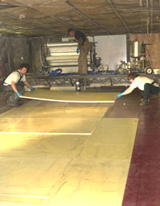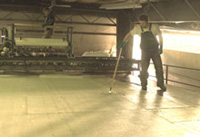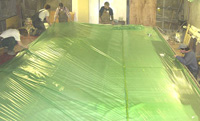The evolution of high performance composite
technologies (i.e. high modulus epoxy resins set in high strength
fibers, laid up over either side of a light weight structural core
material) offers exciting possibilities when used in twin hull construction.
DEADWEIGHT RESTRICTIONS of CATAMARANS
Typically, a twin hulled vessel's limiting disadvantage has been
what is called its deadweight restriction. After a point, as displacement
increases, optimal speed and efficiencies decrease, restricting
the practical ability to load the vessel. The fabrication of a catamaran
hull using high performance composites and advanced processing can
make available a significantly lighter platform when compared to
the traditional polyester fiberglass hull. Obviously, if the static
weight (dead load) of the vessel is minimized, the dynamic loads
(live weight, cargo) can increase enhancing the efficiency of the
vessel at greater loads, and/or allow for a reduction in the power
plant requirements of the vessel.
Aside from the deadweight restriction, catamarans are a superior
hull shape for most applications. The practical advantages of the
hull shape are significant enough to make the production of utility
power catamarans a viable alternative to traditional design concepts.
The obstacle of the vessels deadweight restriction can be overcome
with the use of the high performance composites as the building
material. Simply put, twin hull design criteria calls for the lightest
possible building material. High performance composites, done properly,
offer the greatest strength to weight ratio. As in the aerospace
industry (another weight sensitive arena which utilizes high performance
composites), the high mechanical properties of the materials justify
their use despite their higher costs. Even though these materials
cost more per pound when compared to the traditional polyester laminates,
far less material is used to build the same hull. Costs can also
be minimalized due to the introduction of new production technologies
to the shop floor that increase productivity. We believe the value
of the proposed vessels will exceed their cost to produce.
Five Key Ingredients
To reach the optimal strength to weight ratios for the panel, the
goal on the shop floor is achieve high fiber to resin ratios in
the laminant (by weight) since the strength of the laminant is determined
by the fiber content, not resin content. The resin needs to only
'wet out' the fabric and displace all air voids. Any additional
resin is excess, (excess resin = excess weight). It is possible
to achieve a fiber to resin ratio of 60/40 in the new composites
compared to the typical 30/70 polyester lay-ups. There are 5 key
ingredients to the fabrication process that must be optimized to
achieve the goal of a strong but light product
1. The use of a high modulus epoxy resin.
The higher mechanical and toughness properties of these resins allow
for leaner resin content without sacrificing strength. Also, epoxies
give high bond strengths to core materials. The long 'open time'
of the resin allows for extended process times of up to 8 hours
before cure. This affords the complete assembly of complex laminants
at one time and within a single vacuum bag, increasing shop floor
efficiencies and product quality. The resin is post cured at 140
degrees F after the hull is finished to achieve the high mechanicals.
2. The use of a fabric impregnator.
This equipment controls the amount of resin used per unit of fabric,
providing an even wet-out and consistency throughout the project.
This equipment determines the fiber to resin ratios. All fibrous reinforcing
materials are to be wet out mechanically with the impregnator. It
reduces labor as well as ensures precision. This "wet preg"
material can then be inserted in place as opposed to wetting out by
hand
|
|
| Epoxy is spread evenly throughout
the fiberglass material as it passes through the wheels of the
impregnator. |
Lightweight
structual core is layered with the impregnated fiberglass.
|
3. The use of a lightweight structural core.
The core provides for hull stiffness. The stiffness of a material
is a function of the cube of its thickness. This means a cored laminant
("sandwich") will be as stiff as a solid glass laminant
of the same thickness, but not as heavy. A complete cored laminant
will act much like an 'I beam'. When deflecting loads are applied,
one skin will be in tension, the other in compression. A good core
material will have high shear strengths and will withstand the post
cure temperatures.
4. The use of stronger fabrics.
Stronger fabrics such as S Glass, Carbon fiber, and Kevlar give
the necessary strengths in less plies when compared to the standard
E Glass. Less fabric use also means less resin use, again making
a lighter laminant. Equally important to fabric type is the orientation
of the fibers. The laminant should be engineered so that the orientation
of the fibers accommodate the anticipated loads on the structure.
Finally, a tightly stitched fabric is preferable over a loosely
stitched fabric.
|
|
| Finishing touches are made to the laminated
panel to prepare it for the vacuum bag. |
The green vacuum bag is stretched across
the entire panel and sealed around all edges before the suction
is started. |
5. The use of vacuum bagging technology.
The importance of vacuum bagging a complex laminant with core
materials cannot be overestimated. A vacuum bag compacted laminant
will easily save 30-50% of laminate weight over the same materials
laid up by hand with only the viscosity of the resins to hold the
laminate together until it cures (requiring more resin). A vacuum
will debulk the laminate and ensure that the individual plies contact
each other without puddles of resin between.
|



















